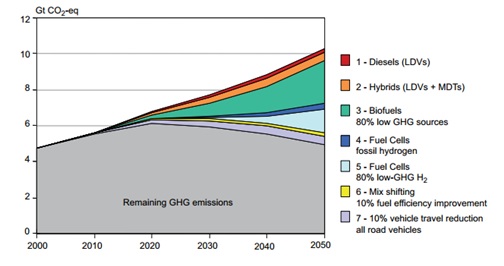Energy Efficiency in Transport
DEFINITION & TYPES OF STRATEGIES
World population is projected to reach 9,6 billon by 2050. As this amount increases, the use of transport and its linked GHG emissions also increase. Transport is one of the responsible for the burning of fuels such as petroleum. For this reason is very important that we have sustainable transport and sustainable energy production. Electricity generated in power plants can also be utilized to run an electric car. In a power plant you can take the waste heat and run a steam turbine and generate a secondary power source which can be used to charge an electric car. Gases released by this burnt include carbon dioxide (CO2), steam (H2O), nitrogen (N2), CO, hydrocarbures (HC) and nitrogen oxides (NOx) These gases are the main responsible for global warming (road transport is the largest contributor to global warming). It has been estimated than world energy consumption in this sector increases by an average of 1.1% per year.
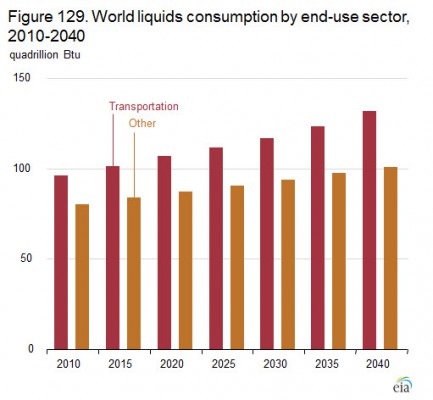
Consumption of petroleum and other kinds of liquid fuels is the highest (63%) in the transport sector from 2010 to 2040. The growth in transportation energy use generally occurs in countries where there are projected economic and population growth, combined with relatively immature transportation sectors. These countries belong to the non-OECD nations. OECD is the Organisation for Economic Co-operation and Development. Non-OECD transportation sector energy consumption increases by an average of 2.2% per year from 2010 to 2040 whilst OECD transportation sector energy use decreases by an average of 0.1% per year due to the slow economic growth, improvements in energy efficiency, and stable or declining population levels.
Energy efficiency of the road transport depends on:
- Vehicle fuel efficiency which is determined by technical energy efficiency.
- Vehicle travel: type of travel.
- Vehicle population: number the vehicles on the road.
Fuel efficiency can be expressed as fuel consumption that is the amount of fuel utilized per unit distance.
The lower the value (F) is, the more economic a vehicle is since it needs less fuel to travel a specific distance.
Diesel engines offer greater fuel efficiency than gasoline engines. Car diesel engines have energy efficiency of 30%, and petrol engines of 20%. Bio-fuels, electricity and hydrogen, for instance, have significant energy inputs in their production. Because of this, the 50-70% efficiency oo hydrogen production has to be combined with the vehicle efficiency to yield net efficiency.
Another consideration to take into account is the occupancy rate of the vehicle. As the number of passengers per vehicle increases the consumption per unit distance per vehicle increases. However this increase is slight compared to the reduction in consumption per unit distance per passenger
Between the behavioral mitigation options we can find Carpooling. Carpool of car-sharing is the act of sharing car journeys with the purpose of more than one person could travel in the same car. Drivers and passengers offer and search for journeys trough different mediums (such as internet). Once done that, both (driver and passengers) contact each other to arrange the details of the journey. In this way, carpooling reduces the travel costs (petrol costs), the traffic, and the stress of driving. Carpooling is a good way to reduce CO2 emissions since it avoids using more than one vehicle. Then, they avoid a bigger amount of CO2 released to the atmosphere.
GREEN VEHICLE
Green vehicles are environmentally friendly since they produce less negative impacts to the environment than comparable conventional internal combustion engine vehicles which work with gasoline or diesel. The energy efficiency of the vehicle’s engine is very important because it can reduce the consumption of petroleum and it can use renewable energies to work. In addition, biofuels can be used instead of petroleum. These vehicles are alternative fuel vehicles. Green vehicles have advanced vehicle technologies that include:
- Hydrid electric vehicles
- Plug-in hybrid vehicles
- Battery electric vehicles
- Compressed-air vehicles
- Hydrogen and fuel-cell vehicles
- Biodiesel, gasohol and ethanol fuel vehicles
Types Electric Vehicles
HYBRID VEHICLES
A hybrid vehicle combines a standard internal combustion engine propulsion system with an electric propulsion system. Fuel efficiency can be increased by about 25 percent from conventional vehicles. The electric motor minimizes idling and the car is able to start and accelerate quickly. Hybrids are dual-fuel vehicles in which both the electric motor and internal combustion engine can drive the wheels. The battery is recharged by the gasoline engine and regenerative braking. Regenerative braking converts kinetic energy that otherwise would be lost as heat in the brake pads into electricity.
There are two basic types of hybrid cars:
- Series hybrids: they run mostly by the battery, but have a petrol or diesel generator to recharge the battery when going on a long drive.
- Parallel hybrids: the car can be directly powered by the internal combustion engine through a system of transmission to the wheels or by one or more electric engines, or by both (electric engine and internal combustion engine at the same time)

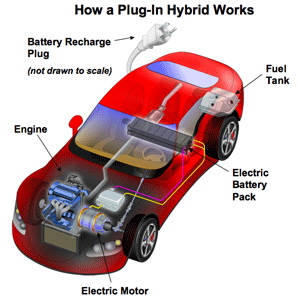
PLUG-IN HYBRID ELECTRIC VEHICLES
Plug-in hybrid electric vehicles (PHEVs) are hybrid vehicles which use rechargeable batteries, or another energy storage device, that can be restored to full charge by connecting a plug to an external electric power source. A Plug-in hybrid has and electric motor, an internal combustion engine and a plug to connect to the electrical grid. The cost for electricity to power plug-in hybrids for all-electric has been estimated at less than one quarter of the cost of gasoline In addition, PHEVs reduce air-pollution and dependence on petroleum. PHEVs reduc emissions that contribute to global warming. PHEVs also eliminate the problem of range anxiety associated to all-electric vehicles, because the combustion engine works as a backup when the batteries are depleted, giving PHEVs driving range comparable to other vehicles with gasoline tanks. However there are some disadvantages such as the cost of batteries and recharging outside home garages, between others.
EXTENDED-RANGE ELECTRIC VEHICLE
Extended-Range electric Vehicles have an internal combustion engine which powers an electric generator. This generator charges the battery in a linear process. The difference between this vehicles and Hybrid and plug-in hybrids is that only the electric motor powers the wheels. The engine only charges the batteries.

BATTERY ELECTRIC VEHICLE
These vehicles do not have internal combustion engine: they have to be plugged into the electric power grid for recharging. These cars have an electric battery to store the energy, an electric engine and an control electronic system.


FUEL CELL POWERED VEHICLES(HIDROGEN VEHICLES)
Hydrogen vehicles are vehicles that utilize hydrogen as their fuel for producing power. The chemical energy that the hydrogen contains is converted to mechanical energy due to the hydrogen burnt in an internal combustion engine. The energy conversion can be obtained by the reaction of the hydrogen with oxygen in a fuel cell to run electric motors. Hydrogen fuel does not exist naturally on Earth and is not an energy source but it can be produced using renewable energy sources.
There are various environmentally friendly ways to produce hydrogen fuel such as:
- Renewable resources.
- Thermochemical processes can produce hydrogen from biomass.
- Sunlight can drive photolytic production of hydrogen from water by use of photoelectrochemical and photobiological processes.
Using hydrogen the vehicle would not contribute to CO2 emissions. However, hydrogen is expensive and has low energy content per unit volume. Hybrid vehicles are partly fossil fueled and partly electric or hydrogen-powered
SOLAR VEHICLES
Solar vehicles are electric vehicles powered by direct solar energy. Photovoltaic cells convert the sun’s energy directly into electric energy. The design of a solar car is limited by the amount of energy input into the car. Even the best solar cells can only collect limited power and energy over the area of a car’s surface. Solar cars lack the safety and convenience features of conventional vehicles. As an alternative, a battery-powered electric vehicle may use a solar array to recharge the batteries. Solar car are not currently in the market, but maybe in a future they will be.

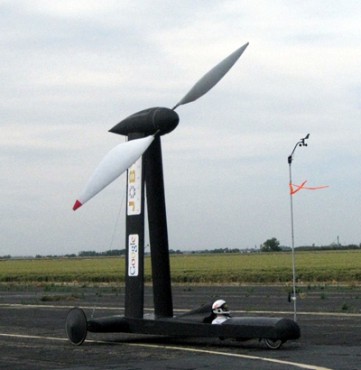
WIND POWERED VEHICLE
Wind-powered mechanical vehicles primarily use wind turbines installed at a strategic point of the vehicle. The wind power, which is converted into mechanical energy through gears, belts or chains, causes the vehicle to propel forward. As solar cars, they are not in the market currently.
COMPRESSED AIR VEHICLE
This kind of car uses a motor powered by compressed air or combined air with gasoline, diesel, ethanol or an electric plant with regenerative braking. Since a compressed air car’s source of energy is usually electricity, its environmental impact depends on how clean the source of this electricity is. Then, the range of emissions can vary from high-emission power sources to zero-emission power sources. Compressed air vehicle has a problem: air storage of energy is less efficient than chemical storage.
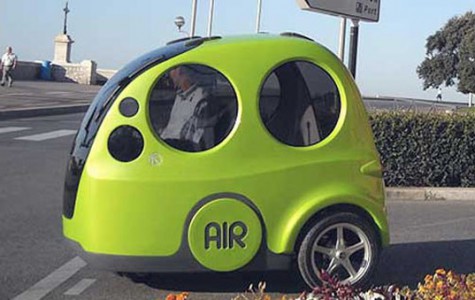
Benefits to the Environment
CO2 emission reductions can vary depending on the technology implemented. If we use hybridation the reduction is about 30-36 per cent. If we use biofuels to power the engine we save between 20-80% of CO2 emissions. If we use hydrogen vehicles the CO2 savings increases up to 45%. The effect of Green vehicles greenhouse emissions is complex. The clean air benefit is usually local because depending on the source of the electricity used to recharge the batteries, air pollutant emissions are shifted to the location of the generation plants. If renewable energies (such as wind power) are used to recharge these vehicles then, less environmental impact occurs.
IEA estimates that there is a potential for cost-effective technical improvement in new vehicle fuel economy of 50% by 2030. This would result in a reduction of close to 500 000 tonnes of oil equivalent (toe) fuel use and almost 1 Gt of annual reduction in CO2 emissions. Achieving this target will be challenging yet possible, but will require strong policies that maximise technology uptake and minimise fuel economy losses due to increases in vehicle size, weight and power.
Trends
By 2050 Diesel is projected to be the most used fuel followed by hybrids and biofuels (with an 80% low GHG sources). Our efforts must be concentrated on encouraging the use of fuel cells (hydrogen fuel), in fuel efficiency improvement and in the use of renewable energies to recharge the cars.
In 2010 the world liquid consumption was 96,1 (million barrels per day- MMBD). By 2035 it has been estimated a total amount of liquid consumption for transportation of 123,5 MMB.
1 million barrels per day= 1.38009805 m3 / s
We can observe the following graph where the trends in fuel market penetration is presented:
